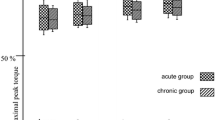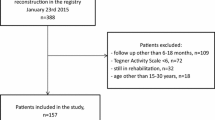Abstract
A total of 167 patients with documented anterior cruciate ligament deficiency was examined preoperatively with laxity and isokinetic muscle strength measurements. Functional evaluation with Lysholm knee and Tegner activity level scores were done. Antero-posterior (AP) knee laxity correlated negatively with Tegner activity level (NS), and insignificantly with Lysholm knee score. A marginal correlation was found between the Lysholm score and muscle strength. Patients were divided into four groups depending on whether their AP laxity was greater or less than 20 mm and whether their quadriceps strength was greater or less than 85% of their control knee. No difference in the Lysholm or Tenger scores between the groups was observed. As a conclusion it seems that even a relatively good muscle performance does not compensate severe instability symptoms.
Similar content being viewed by others
References
Brewster CE, Moynes DR, Jobe FW (1983) Rehabilitation for anterior cruciate reconstruction. J Orthop Sports Phys Ther 5: 121–126
Ciccotti MG, Kerlan RK, Perry J, Pink M (1994) An electromyographic analysis of the knee during functional activities. II. The anterior cruciate ligament-deficient and-reconstructed profiles. Am J Sports Med 22: 651–658
Elmqvist L-G (1988) Chronic anterior cruciate ligament tear. Knee function and knee extensor muscle size, morphology and function before and after surgical reconstruction. Umeå University Medical Dissertation no. 229, Umeå, Sweden
Engstrom B, Gornitzka J, Johansson C, Wredmark T (1993) Knee function after anterior cruciate ligament ruptures treated conservatively. Int Orthop 17: 208–213
Eriksson E (1981) Rehabilitation of muscle function after sport injury-major problem in sports medicine. Int J Sports Med 2: 1–6
Fossier E, Christel P, Djian P, Darman Z, Witvoët J (1993) Principles and value of isokinetic assessment in rupture of the anterior cruciate ligament. Fr J Orthop Surg 7: 510–519
Gerber C, Hoppeler H, Claassen H, Robotti G, Zehnder R, Jakob RP (1985) The lower-extremity musculature in chronic symptomatic instability of the anterior cruciate ligament. J Bone Joint Surg [Am] 67: 1034–1043
Giove TP, Miller SJ, Kent BE (1983) Non-operative treatment of the torn anterior cruciate ligament. J Bone Joint Surg [Am] 65: 184–192
Grimby G, Gustafsson E, Peterson L, Renström P (1980) Quadriceps function and training after knee ligament surgery. Med Sci Sports 12: 70–75
Hagood S, Solomonow M, Baratta R, Zhou BH, D'Amrosia R (1990) The effect of joint velocity on the contribution of the antagonist musculature to knee stiffness and laxity. Am J Sports Med 18: 182–187
Harter RA, Osternig LR, Standifer BA (1990) Isokinetic evaluation of quadriceps and hamstrings symmetry following anterior cruciate ligament reconstruction. Arch Phys Med Rehabil 71: 465–468
Ikeda H (1993) Isokinetic torque of quadriceps in patients with untreated anterior cruciate ligament injury of the knee joint. Nippon Seikeigeka Gakkai Zasshi 67: 826–835
Jennings AG (1994) A proprioceptive role for the anterior cruciate ligament: a review of the literature. J Orthop Rheum 7: 3–13
Kannus P (1988) Ratio of hamstring to quadriceps femoris muscles' strength in the anterior cruciate ligament insufficient knee. Relationship to long-term recovery. Phys Ther 68: 961–965
Kannus P, Latvala K, Järvinen M (1987) Thigh muscle strength in the anterior cruciate ligament deficient knee: isokinetic and isometric long-term results. J Orthop Sports Phys Ther 9: 223–227
Kramer J, Nusca D, Fowler P, Webster-Bogaert S (1993) Knee flexor and extensor strength during concentric and eccentric muscle actions after anterior cruciate ligament reconstruction using the semitendinosus tendon and ligament augmentation device. Am J Sports Med 21: 285–291
LoPresti C, Kirkendall T, Street GM, Dudley AW (1988) Quadriceps insufficiency following repair of the anterior cruciate ligament. J Orthop Sports Phys Ther 9: 245–249
Lorentzon R, Elmqvist L-G, Sjöström M, Fagerlund M, Fugl-Meyer AR (1989) Thigh musculature in relation to chronic anterior cruciate ligament tear: muscle size, morphology, and mechanical output before reconstruction. Am J Sports Med 17: 423–429
Mononen T, Alaranta H, Harilainen A, Sandelin J, Vanhanen I, Österman K (1994) Instrumented measurement of anteriorposterior translation in knees with chronic anterior cruciate ligament tea. Arch Orthop Traum Surg (in press)
Murray SM, Warren RF, Otis JC, Kroll M, Wickiewicz TL (1984) Torque-velocity relationships of the knee extensor and flexor muscles in individuals sustaining injuries of the anterior cruciate ligament. Am J Sports Med 12: 436–440
Odensten M, Tegner Y, Lysholm J, Gillquist J (1983) Knee function and muscle strength following distal iliotibial band transfer (DIT) for anterolateral rotatory instability. Acta Orthop Scand 54: 924–928
Seto JL, Orofino AS, Morrissey MC, Medeiros JM, Mason WJ (1988) Assessment of quadriceps/hamstring strength, knee ligament stability, functional and sports activity levels five years after anterior cruciate ligament reconstruction. Am J Sports Med 16: 170–180
Solomonow M, Baratta R, Zhou BH, Shoji H, Bose W, Beck C, D'Ambrosia R (1987) The synergistic action of the anterior cruciate ligament and thigh muscles in maintaining joint stability. Am J Sports Med 15: 207–213
Tegner Y, Lysholm J (1985) Rating systems in the evaluation of knee ligament injuries. Clin Orthop 198: 43–49
Tegner Y, Lysholm J, Gillquist J, Öberg B (1984) Two-year follow-up of conservative treatment of knee ligament injuries. Acta Orthop Scand 55: 176–180
Tegner Y, Lysholm J, Lysholm M, Gillquist J (1986) Strengthening exercises for old cruciate ligament tears. Acta Orthop Scand 57: 130–134
Tibone JE, Antich TJ (1988) A biomechanical analysis of anterior cruciate ligament reconstruction with the patellar tendon. A two year followup. Am J Sports Med 16: 332–335
Tibone JE, Antich TJ, Fanton GS, Moynes DR, Perry J (1986) Functional analysis of anterior cruciate ligament instability. Am J Sports Med 14: 276–284
Walla DJ, Albright JP, McAuley E, Martin RK, Eldridge V, El-Khoury (1985) Hamstring control and the unstable anterior cruciate ligament-deficient knee. Am J Sports Med 13: 34–39
Author information
Authors and Affiliations
Rights and permissions
About this article
Cite this article
Harilainen, A., Alaranta, H., Sandelin, J. et al. Good muscle performance does not compensate instability symptoms in chronic anterior cruciate ligament deficiency. Knee Surg, Sports traumatol, Arthroscopy 3, 135–137 (1995). https://doi.org/10.1007/BF01565471
Received:
Accepted:
Issue Date:
DOI: https://doi.org/10.1007/BF01565471




